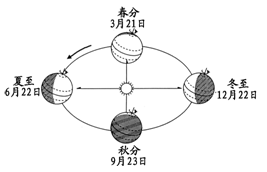问题
选择题
2012年5月21日晨,福州的天空中出现了瑰丽的日环食,读图,回答下列各题:

小题1:出现日环食当天最接近的节气是( )
A.春分
B.夏至
C.秋分
D.冬至小题2:当天,福州的昼夜长短情况是( )
A.昼夜等长
B.昼短夜长
C.昼长夜短
D.出现极昼小题3:地球公转的周期是( )
A.1个月
B.1年
C.一天
D.半年
答案
小题1:B
小题2:C
小题3:B
题目分析:
小题1:福州是福建省会,属于北半球,出现日环食时是5月21日,读图可知,该日位于春分3月21日与夏至6月22日之间,并且接近夏至,故选B.
小题2:出现日环食当天是5月21日,读图可知,该日位于春分3月21日与夏至6月22日之间,此段时间内,太阳直射点由赤道向北回归线移动,即太阳直射点在北半球,因此北半球的昼夜长短情况是昼长夜短,故选C.
小题3:地球在自转的同时还要绕着太阳转动叫地球公转,地球公转方向与自转方向一样都是自西向东,公转的周期为一年,地球公转产生的现象是季节的变化和太阳高度角的变化,故选B.
